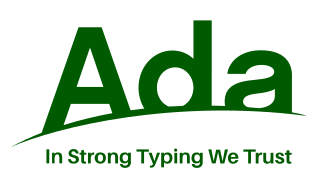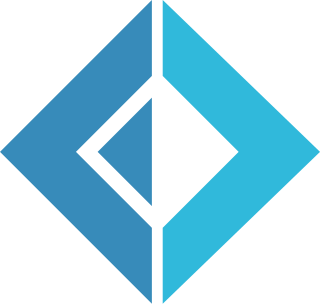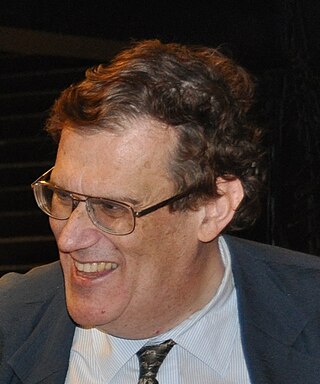Related Research Articles

Ada is a structured, statically typed, imperative, and object-oriented high-level programming language, inspired by Pascal and other languages. It has built-in language support for design by contract (DbC), extremely strong typing, explicit concurrency, tasks, synchronous message passing, protected objects, and non-determinism. Ada improves code safety and maintainability by using the compiler to find errors in favor of runtime errors. Ada is an international technical standard, jointly defined by the International Organization for Standardization (ISO), and the International Electrotechnical Commission (IEC). As of May 2023, the standard, called Ada 2022 informally, is ISO/IEC 8652:2023.

Recursion occurs when the definition of a concept or process depends on a simpler or previous version of itself. Recursion is used in a variety of disciplines ranging from linguistics to logic. The most common application of recursion is in mathematics and computer science, where a function being defined is applied within its own definition. While this apparently defines an infinite number of instances, it is often done in such a way that no infinite loop or infinite chain of references can occur.
In computer science, denotational semantics is an approach of formalizing the meanings of programming languages by constructing mathematical objects that describe the meanings of expressions from the languages. Other approaches providing formal semantics of programming languages include axiomatic semantics and operational semantics.
In mathematics, a unary operation is an operation with only one operand, i.e. a single input. This is in contrast to binary operations, which use two operands. An example is any function f : A → A, where A is a set. The function f is a unary operation on A.

GNAT is a free-software compiler for the Ada programming language which forms part of the GNU Compiler Collection (GCC). It supports all versions of the language, i.e. Ada 2012, Ada 2005, Ada 95 and Ada 83. Originally its name was an acronym that stood for GNU NYU Ada Translator, but that name no longer applies. The front-end and run-time are written in Ada.
In mathematics, an empty product, or nullary product or vacuous product, is the result of multiplying no factors. It is by convention equal to the multiplicative identity, just as the empty sum—the result of adding no numbers—is by convention zero, or the additive identity. When numbers are implied, the empty product becomes one.

F# is a general-purpose, strongly typed, multi-paradigm programming language that encompasses functional, imperative, and object-oriented programming methods. It is most often used as a cross-platform Common Language Infrastructure (CLI) language on .NET, but can also generate JavaScript and graphics processing unit (GPU) code.
SPITBOL is a compiled implementation of the SNOBOL4 programming language. Originally targeted for the IBM System/360 and System/370 family of computers, it has now been ported to most major microprocessors including the SPARC. It was created by Robert Dewar and Ken Belcher, who were then at the Illinois Institute of Technology.
Set theoretic programming is a programming paradigm based on mathematical set theory. One example of a programming language based on this paradigm is SETL. The goal of set theoretic programming is to improve programmer speed and productivity significantly, and also enhance program clarity and readability.
In computer science, a tail call is a subroutine call performed as the final action of a procedure. If the target of a tail is the same subroutine, the subroutine is said to be tail recursive, which is a special case of direct recursion. Tail recursion is particularly useful, and is often easy to optimize in implementations.

The Courant Institute of Mathematical Sciences is the mathematics research school of New York University (NYU). Founded in 1935, it is named after Richard Courant, one of the founders of the Courant Institute and also a mathematics professor at New York University from 1936 to 1972, and serves as a center for research and advanced training in computer science and mathematics. It is located on Gould Plaza next to the Stern School of Business and the economics department of the College of Arts and Science.

Jacob Theodore "Jack" Schwartz was an American mathematician, computer scientist, and professor of computer science at the New York University Courant Institute of Mathematical Sciences. He was the designer of the SETL programming language and started the NYU Ultracomputer project. He founded the New York University Department of Computer Science, chairing it from 1964 to 1980.
The Leonard N. Stern School of Business is the business school of New York University, a private research university based in New York City. Founded as the School of Commerce, Accounts and Finance in 1900, the school received its current name in 1988.
The New York University's Ultracomputer is a significant processor design in the history of parallel computing. The system has N processors, N memories, and an N log N message-passing switch connecting them. The system supported an innovative fetch-and-add process coordination instruction, and the custom VLSI network switches could combine references from several processors into a single reference, to reduce memory contention.

Yann André LeCun is a Turing Award winning French-American computer scientist working primarily in the fields of machine learning, computer vision, mobile robotics and computational neuroscience. He is the Silver Professor of the Courant Institute of Mathematical Sciences at New York University and Vice-President, Chief AI Scientist at Meta.
This article describes the features in the programming language Haskell.
Haskell is a general-purpose, statically-typed, purely functional programming language with type inference and lazy evaluation. Designed for teaching, research, and industrial applications, Haskell has pioneered a number of programming language features such as type classes, which enable type-safe operator overloading, and monadic input/output (IO). It is named after logician Haskell Curry. Haskell's main implementation is the Glasgow Haskell Compiler (GHC).

Robert Berriedale Keith Dewar was an American computer scientist and educator. He helped to develop programming languages and compilers and was an outspoken advocate of freely licensed open-source software. He was a cofounder, CEO, and president of the AdaCore software company. He was also an enthusiastic amateur performer and musician, especially with the Village Light Opera Group in New York City.
References
- 1 2 3 4 5 6 7 8 9 Schwartz, J. T.; Dewar, R. B. K.; Schonberg, E.; Dubinsky, E. (1986). "Programming with Sets". SpringerLink: v–vii, 2, 48, 53, 57–58, 63, 113ff. doi:10.1007/978-1-4613-9575-1.
- 1 2 "GNU SETL Om". setl.org. Retrieved 2024-04-24.
- 1 2 Markoff, John (2009-03-04). "Jacob T. Schwartz, 79, Restless Scientist, Dies". The New York Times. ISSN 0362-4331 . Retrieved 2024-04-24.
- ↑ Computational Logic and Set Theory. pp. vii. doi:10.1007/978-0-85729-808-9.
- 1 2 "CHAPTER 2". www.settheory.com. Retrieved 2024-04-24.
- ↑ "CHAPTER 3". www.settheory.com. Retrieved 2024-04-24.
- 1 2 "CHAPTER 3". www.settheory.com. Retrieved 2024-04-24.
- ↑ "CHAPTER 4". www.settheory.com. Retrieved 2024-04-24.
- ↑ J.T. Schwartz; R.B.K. Dewar; E. Dubinsky; E. Schonberg (1986). Programming with sets. An Introduction to SETL. Springer-Verlag New York Inc. ISBN 978-1-4613-9577-5.
- ↑ И.В. Поттосин, ed. (2001). Становление новосибирской школы программирования (мозаика воспоминаний) [Formation of the Novosibirsk school of programming (mosaic of memories)](PDF) (in Russian). Новосибирск: Институт систем информатики им. А. П. Ершова СО РАН. pp. 106–113.
- ↑ Dewar, Robert B. K.; Fisher Jr., Gerald A.; Schonberg, Edmond; Froelich, Robert; Bryant, Stephen; Goss, Clinton F.; Burke, Michael (November 1980). "The NYU Ada translator and interpreter". Proceeding of the ACM-SIGPLAN symposium on Ada programming language - SIGPLAN '80. Vol. 15. pp. 194–201. doi:10.1145/948632.948659. ISBN 0-89791-030-3. S2CID 10586359.
- ↑ SofTech Inc., Waltham, MA (1983-04-11). "Ada Compiler Validation Summary Report: NYU Ada/ED, Version 19.7 V-001". Archived from the original on June 7, 2017. Retrieved 2010-12-16.
{{cite web}}: CS1 maint: multiple names: authors list (link) - ↑ Python-Dev: SETL (was: Lukewarm about range literals)
- 1 2 "SETL2 - EDM2". www.edm2.com. Retrieved 2024-04-24.
- ↑ Baxter Hastings, Nancy; Dubinsky, Ed; Levin, Gary (1989). Learning discrete mathematics with ISETL. New York: Springer-Verlag. ISBN 978-0-387-96898-8.
- ↑ "GNU SETL". setl.org. Retrieved 2024-04-24.